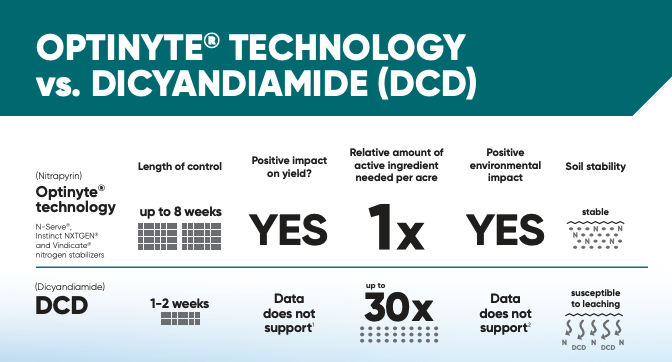Nitrogen Stabilization Myths, Debunked

Are your customers considering a nitrogen stabilizer but not sure if it’s worth the investment? We debunked some of the most common nitrogen management and stabilization myths, so you can help them make the best choices for their operations.
Myth: Stabilizers can be replaced by an additional nitrogen application later in the season.
Fact: Adding excess nitrogen later in the season does not automatically equate to an increase in yield or profit, because there is no guarantee the nutrient will be there when the corn needs it.
No matter how much nitrogen customers apply, or the timing of application, nitrogen will be vulnerable to loss from leaching, denitrification and volatilization. And with high fertilizer prices, the cost of putting more nitrogen on the field can quickly add up.
Fact: N-Serve® and Instinct NXTGEN® nitrogen stabilizers are proven to increase yield by 5.2% when used with spring nitrogen applications and by 7% when used with fall applications.1
Myth: Nitrogen stabilizers tie up nitrogen, making it unavailable for corn to use.
Fact: N-Serve and Instinct NXTGEN do not “tie up” nitrogen. Rather, they protect the nutrient from loss by keeping nitrogen in the root zone for when corn needs it most.
“Stabilizers reduce the loss of nitrogen by slowing down the bacteria that converts ammonium to nitrate,” explained Clark Smith, product manager, Nutrient Maximizers and row crop fungicides, Corteva Agriscience. “By allowing nitrogen to remain in the ammonium form, leaching and denitrification are significantly reduced because the nitrate form is much more susceptible to these forms of loss than the ammonium form.”
Myth: Nitrogen stabilizers kill soil bacteria.
Fact: Optinyte® technology (nitrapyrin), the active ingredient in N-Serve and Instinct NXTGEN, is bacteriostatic, meaning that it slows, not kills, the activity of Nitrosomonas bacteria in the soil.
Myth: A stabilizer isn’t needed with spring or sidedress applications.
Fact: Nitrogen is vulnerable to loss no matter when it’s applied. Heavy spring rains and warming temperatures are some of the biggest drivers of leaching and denitrification.
A proven nitrogen stabilizer protects against these losses, helping to ensure your customers get the best return on their nitrogen investment – no matter when it’s applied.
Myth: Growers in areas with little rainfall don’t need to worry about nitrogen loss.
It’s important to remember that leaching is not the only type of nitrogen loss – and several factors besides rain can cause loss.
Fact: Approximately five weeks after a nitrogen application, only 20% of nitrogen is left in the most efficient ammonium form. Corn requires 6 to 7 pounds of nitrogen per acre per day 40 days after emergence — making it essential to extend nitrogen in all field conditions.
Myth: Liquid manure does not benefit from nitrogen stabilization.
Fact: Manure is becoming an increasingly important fertilizer type across Midwestern cornfields in fall and spring. But just like other nitrogen sources, it’s susceptible to loss through leaching and denitrification.
Fact: University of Minnesota research showed that adding Instinct NXTGEN to fall-applied swine manure increased corn grain yield 10 to 12 bu./A compared with not using a nitrogen stabilizer, when averaged across manure application timings. 2
Myth: All nitrogen stabilizers are the same.
Fact: It takes more than 10 times the rate of dicyandiamide (DCD) to be as effective as the standard rate of Optinyte® technology (nitrapyrin), the active ingredient in N-Serve and Instinct NXTGEN.3
Fact: DCD is water-soluble and can leach away with the first significant rainfall event, in contrast to nitrapyrin, which remains in the root zone continually protecting your nitrogen from losses.4

Get more information on Optinyte® technology vs. DCD here.
“The benefits of nitrogen stabilization with Optinyte technology are vast, but it can be harder to see the direct impact in fields when compared with using a herbicide, fungicide or insecticide,” Smith said. “That’s why our nitrogen stabilizers are backed by more than 1,000 field trials and university research experiments.”
Contact your local Corteva Agriscience representative to find the right nutrient management solutions for your customers’ operations. And if you’ll be at Commodity Classic this year, be sure to check out our learning center session on maximizing nitrogen fertilizer applications. Learn more at NutrientMaximizers.com.
1 Rodgers, G. A., and J. Ashworth. 1982. Bacteriostatic action of nitrification inhibitors. Can J Microbiol. 28: 1093–1100.
2 Vetsch, J., and J. Lamb. 2011. Applying Instinct™ as a nitrogen stabilizer for fall applied manure.
3 Wolt, J. D. 2004. A meta-evaluation of nitrapyrin agronomic and environmental effectiveness with emphasis on corn production in the Midwestern USA. Nutrient Cycling in Agroecosystems. 69: 23–41.
4 Watanabe, T. 2006. Influence of 2-chloro-6 (trichloromethyl) pyridine and dicyandiamide on nitrous oxide emission under different soil conditions. Soil Sci Plant Nutr. 52: 226–232.
Instinct NXTGEN® and Vindicate™ are not registered for sale or use in all states. Contact your state pesticide regulatory agency to determine if a product is registered for sale or use in your state. Do not fall-apply anhydrous ammonia south of Highway 16 in the state of Illinois. Optinyte® is a registered active ingredient. Always read and follow label directions.